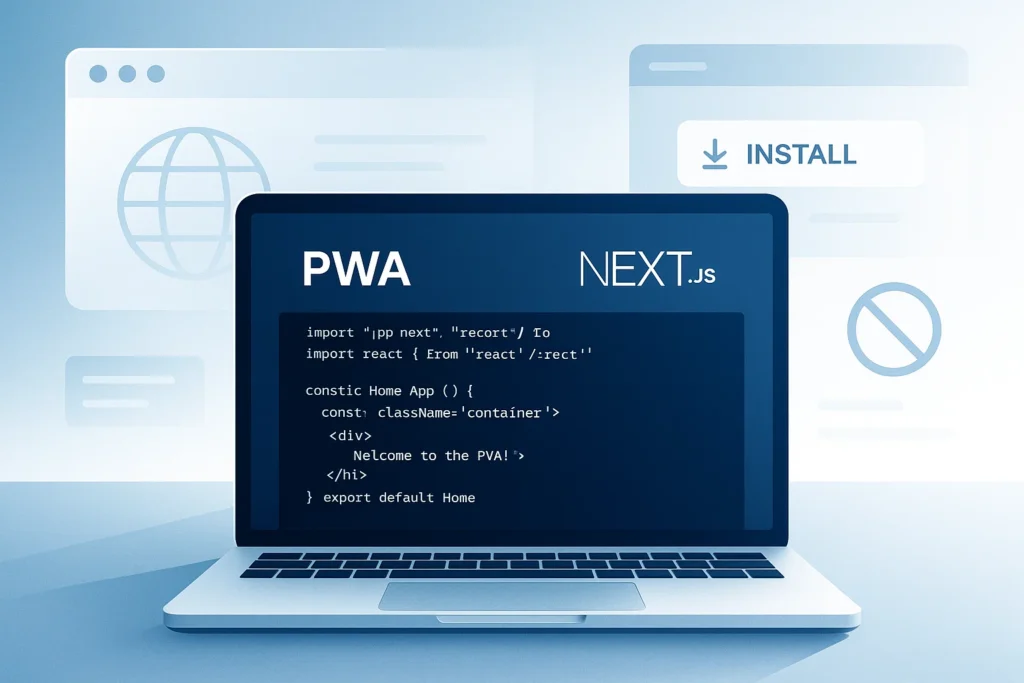Introduction
In 2026, web users expect lightning-fast performance, offline support, and app-like experiences all from their browsers. That’s where Progressive Web App (PWAs) come in.
A progressive web app combines the accessibility of a website with the interactivity and reliability of a native app. And with the release of Next.js 16, building a high-performance PWA has never been easier.
In this complete guide, you’ll learn how to build a Progressive Web App with Next.js 16, step-by-step, from setup to deployment.
What Is a Progressive Web App (PWA)?
A Progressive Web App (PWA) is a type of web application that uses modern web capabilities to deliver a native app-like experience. It can:
- Work offline or in low-network conditions
- Send push notifications
- Be installed on desktops and mobile devices
- Offer fast load times and smooth navigation
PWAs use technologies like Service Workers, Web App Manifests, and HTTPS to deliver these features.
Why Build a PWA with Next.js 16?
Next.js 16 simplifies the process of creating fast, SEO-friendly, and reliable applications. It now includes improved caching, image optimization, and React Compiler support, all essential for progressive web applications.
Here’s why developers prefer Next.js for PWAs:
- ✅ Automatic static optimization for lightning-fast performance
- ✅ Built-in image and script optimization
- ✅ Easy integration with service workers
- ✅ Server-side rendering (SSR) for better SEO
- ✅ Improved caching APIs with
revalidateTag()andupdateTag()
Step 1: Set Up Your Next.js 16 Project
Start by creating a new Next.js project using the latest version:
npx create-next-app@latest my-pwa-app
cd my-pwa-appThen install the PWA plugin for Next.js:
npm install next-pwaThis plugin helps generate and manage service workers automatically.
Step 2: Configure Your next.config.js
Open your next.config.js and add the PWA configuration:
const withPWA = require('next-pwa')({
dest: 'public',
register: true,
skipWaiting: true,
});
const nextConfig = withPWA({
reactCompiler: true, // New in Next.js 16
experimental: {
cacheComponents: true,
},
});
module.exports = nextConfig;What this does:
dest: 'public'→ Service worker will be generated in the public folder.register→ Automatically registers the service worker.skipWaiting→ Ensures updates apply immediately.
Step 3: Add a Web App Manifest
Create a file named manifest.json inside the public/ directory:
{
"name": "My Next.js PWA",
"short_name": "NextPWA",
"start_url": "/",
"display": "standalone",
"background_color": "#ffffff",
"theme_color": "#000000",
"icons": [
{
"src": "/icons/icon-192x192.png",
"sizes": "192x192",
"type": "image/png"
},
{
"src": "/icons/icon-512x512.png",
"sizes": "512x512",
"type": "image/png"
}
]
}Then, link it in your _document.js:
<link rel="manifest" href="/manifest.json" />
<meta name="theme-color" content="#000000" />This manifest allows your Progressive Web App to be installed on devices like a native app.
Step 4: Add Offline Support
Next, create a simple offline fallback page:
pages/_offline.js
export default function Offline() {
return (
<main style={{ padding: "2rem", textAlign: "center" }}>
<h1>You’re offline</h1>
<p>Please reconnect to the internet to continue using the app.</p>
</main>
);
}The next-pwa plugin automatically serves this page when the user loses connectivity.
Step 5: Test Your PWA
Run your project in production mode:
npm run build
npm run startThen open Lighthouse in Chrome DevTools and run the PWA audit.
You should see a “PWA” score above 90 if everything is configured correctly.
Step 6: Deploy and Go Live
You can deploy your PWA easily to:
- Vercel (officially recommended)
- Netlify
- Cloudflare Pages
After deployment, open your website in Chrome → click the Install App icon in the address bar. You’ll see your Progressive Web App installed like a native app.
Common Mistakes to Avoid
- Forgetting HTTPS — Service workers only work over secure connections.
- Missing icons in the manifest — Required for installability.
- Not updating the service worker — Always rebuild after changes.
- Ignoring caching strategies — Use runtime caching for better offline experience.
Final Thoughts
Building a Progressive Web App with Next.js 16 gives you the best of both worlds, the power of React and the reliability of native apps.
By combining Next.js 16’s new caching model, React Compiler, and PWA technologies, developers can build faster, more resilient, and SEO-friendly web experiences that users love.
The web is moving toward app-like performanceand PWAs built with Next.js are leading the way.
